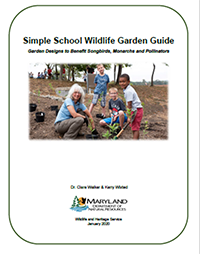What Is A Schoolyard Habitat?
A schoolyard habitat is a living laboratory that provides an outdoor location for students to learn and grow, as well as a home for native wildlife. Imagine a schoolyard filled with engaged students who are busy observing, discovering, playing, and learning amid trees, flowers, birds, and insects.

A schoolyard habitat is a place where students of all ages can discover the wonders of the natural world, achieve a sense of happiness and totality, learn to work cooperatively in positive new ways, and gain the strength and confidence needed to succeed.
The following pages serve as a resource for creating and maintaining schoolyard habitats as well as ways to connect the habitats to learning goals.
For a printable guide to Simple School Wildlife Gardens, please click here.
Photo by: Caroline Blizzard, Maryland State Parks
What Benefits Does A Schoolyard Habitat Provide?
Almost 20 years ago, researchers reported that 92% of classrooms that integrated the outdoors had higher test scores, grades, and enthusiasm for learning. Since that time, numerous studies have highlighted the many measurable benefits that schoolyard habitats provide. Over the past 2 decades, studies have demonstrated that schoolyard habitats:
-
Improve academic outcomes
-
Increase attention and self-discipline
- Improve participation and engagement
- Reduce disciplinary problems
- Improve grades, test scores, and graduation rates
-
Provide physical health benefits
- Increase duration of physical activity
- Encourage diversity of physical play
- Lower blood pressure, heart rate
-
Provide mental health benefits
- Increase creativity, happiness
- Improve resilience to stress, self-esteem
- Decrease stress, depression, anxiety
-
Promote beneficial play and interaction
- Facilitate respect and cooperation among individuals
- Enhance problem-solving and conflict management skills
- Allow for appropriate level and type of physical play
Additional Information on the Benefits of Green Spaces
Other Helpful Links
For more information, please contact:
Sarah B. Witcher
410-260-8566
[email protected]
Department of Natural Resources
Wildlife and Heritage Service
580 Taylor Avenue, E-1
Annapolis, Maryland 21401